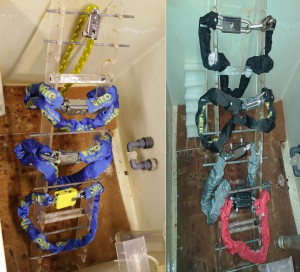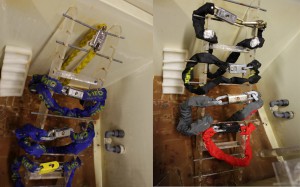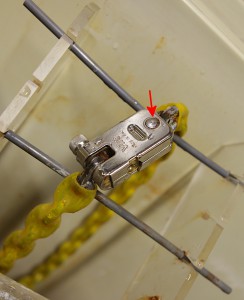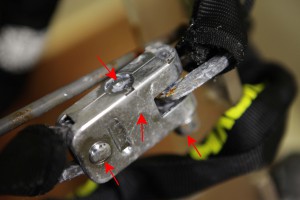As mentioned in chapter I of this series of blogs, after analysing the construction differences which can be detected by the naked eye, we subjected the original Made in Italy Viro “Morso” and the imitations imported from eastern Europe to the same durability and strength tests.
The results fully confirmed our expectations, but we realise that, for the uninitiated, they can seem quite surprising; so we are publishing the test results.
The first test we performed, was the resistance to corrosion caused by salt spray.
This test reproduces a process of “accelerated aging” by creating, in a special machine, an extremely hot, humid and corrosive atmosphere, where the products undergo, for every hour of the test, the equivalent of about one week’s exposure, outdoors, to every type of aggressive atmospheric agent. We introduced into the machine the 4 original Viro padlocks with chain and the 4 imitations, which will all be subject of specific forthcoming blogs.
The salt spray was then activated and left to act for 40 hours, which corresponded to about one year of life in a real environment, subjected to harsh weather conditions.
The photos below show the products placed in the salt spray machine before the start of the test.

On the left original Viro products in the salt spray machine before testing, on the right imitations.
The machine was opened after 40 hours and this was what was found.

On the left original Viro products in the salt spray machine after testing, on the right imitations.
Let’s focus on the “Morso” padlock and on its imitation, which represent the object of this analysis: the comparison of the other types of padlock with chain will be covered in a future blog.
As can be seen, the only point that shows some signs of oxidation in the Viro “Morso” is the rivet which locks the padlock to the chain – component which is not linked to the resistance of the product – whilst the outer armour and, above all, the internal mechanism, are free from corrosion.
However, there are many small points of corrosion in the copy, not only on the rivet, but also on the grip of the lock-bolt and on the armour. It may not seem very significant, but it is actually a sign of a much more serious corrosion of the internal mechanism.
So much so that, as can be seen the short video below, after the salt spray test, whilst the original Viro product still opens and works perfectly, the copy is blocked and the key will not turn, even with the help of pliers.
The second test we performed on our product and on the imitation is the attempt to cut the chain. We therefore used a machine present in our test laboratory which, by using a mechanical arm, operates a hacksaw, and we tried to saw off a Made in Italy chain link and then one of the imitation product.
As you can see in the video below, the chain of the Viro product, as it is tempered and case-hardened, withstands the cutting with the saw.
On the other hand, the chain of the imitation product shows that it has been manufactured simply with iron which has not been heat treated, so it can be very easily cut with a hacksaw.
So let’s see the comparison of the 2 chains after the cutting test.
Obviously, as repeatedly mentioned in several previous blogs, tempering and case-hardening are not sufficient conditions to be able to claim that the chain withstands any type of cutting. We know that cutters with long handles and rotating disks can be very dangerous for all chains.
Therefore, in addition to a correct positioning of the chain (to keep it as high off the ground as possible), the size of the cross section of the links, which withstand the action of these cutting tools, must also increase in relation to the value of the asset to be protected and the risky nature of environment where the asset itself is stored.
But we can say without a shadow of doubt that tempering and case-hardening of the steel used to produce the chains is necessary in order for the chains to be considered suitable for use with padlocks to protect two wheeled vehicles. Chains made of simple iron which has not been heat treated do not offer any true protection.
The third test we performed concerns the resistance of the padlocks themselves, that is, of the Viro “Morso” and the imitation product.
Again within the testing laboratory, we have inserted the products, using the same type of chain link, in a tool which reproduces the blows delivered from a height of 1 m, from the top downwards, with a weight of 3.05 kg as if it were being attacked with a hammer in an attempt to break the joint between the lock-bolt of the padlock and the chain.
We can see that after being struck 5 times the Viro “Morso” loses the head of the lock-bolt, at the programmed breakage point, so that the padlock remains closed and it is not possible to grasp the remaining part of the lock-bolt to pull it away. The armour is obviously damaged at the point where it is repeatedly struck, but the padlock does not open and the chain remains anchored to the lock-bolt.
On the contrary, we can see that after just a couple of blows the imitation product literally splits into two; the lock-bolt comes out and can be removed by hand freeing up the chain, the “armour” folds back on itself and the body breaks. This is evidently due both to inexpensive materials (such as the zamak alloy) which are not suitable for use in components of security products potentially subject to attack and the lack of heat treatment which gives strength to the materials themselves.
At the end of this test, the result is truly shocking for the imitation, compared with the original Viro product.
Summing up, the comparison in parallel with the naked eye, the checking of the materials and, even more, the strength tests, unequivocally confirm that the imitations of the Viro “Morso” do not stand comparison with the original product.
These copies are made with the aim of confusing users, by means of the similar appearance, who are seeking adequate protection for their bikes, but they do not offer any real defence.
One padlock is not worth the same as another, Viro is worth more!
Beware of imitations.
Look at the data sheet of the Viro “Morso” padlock with chain.



